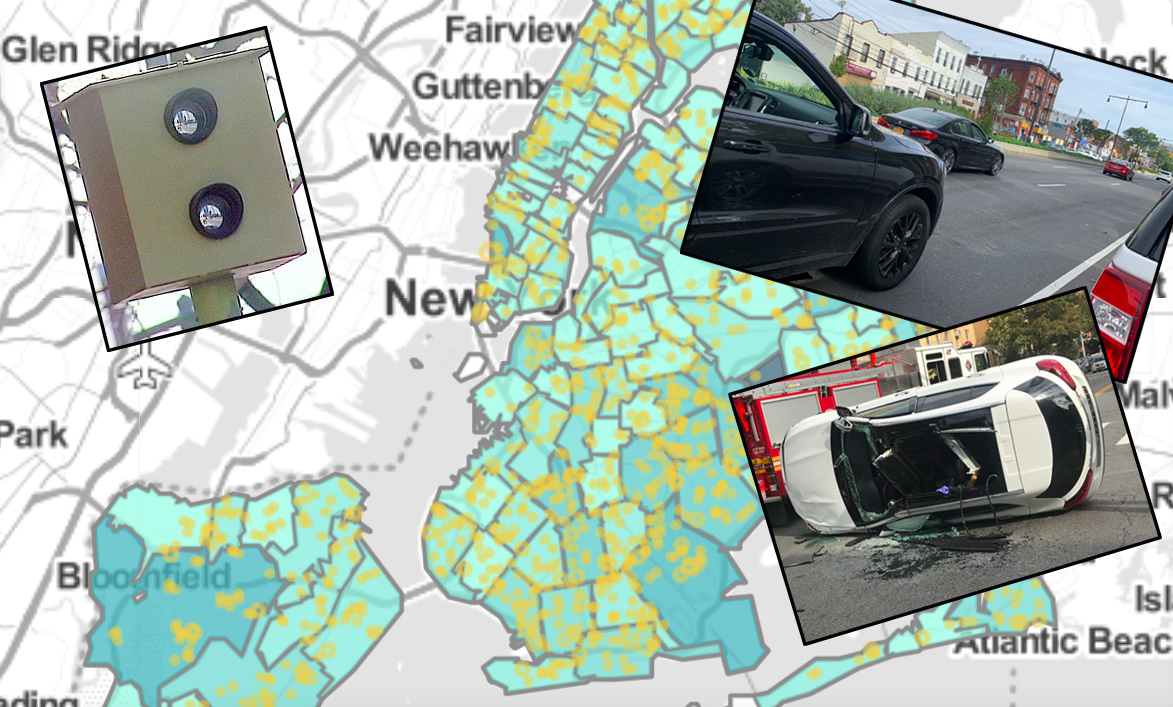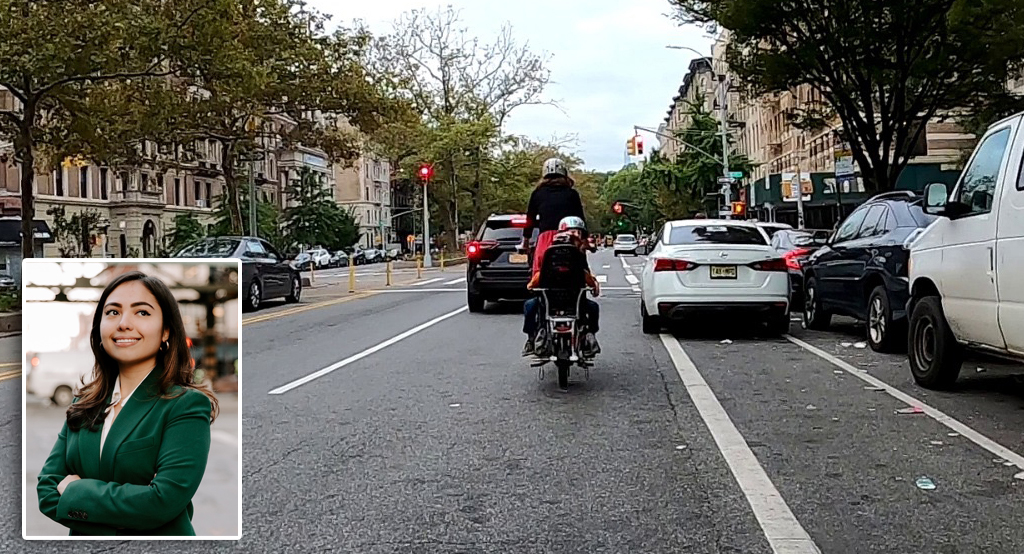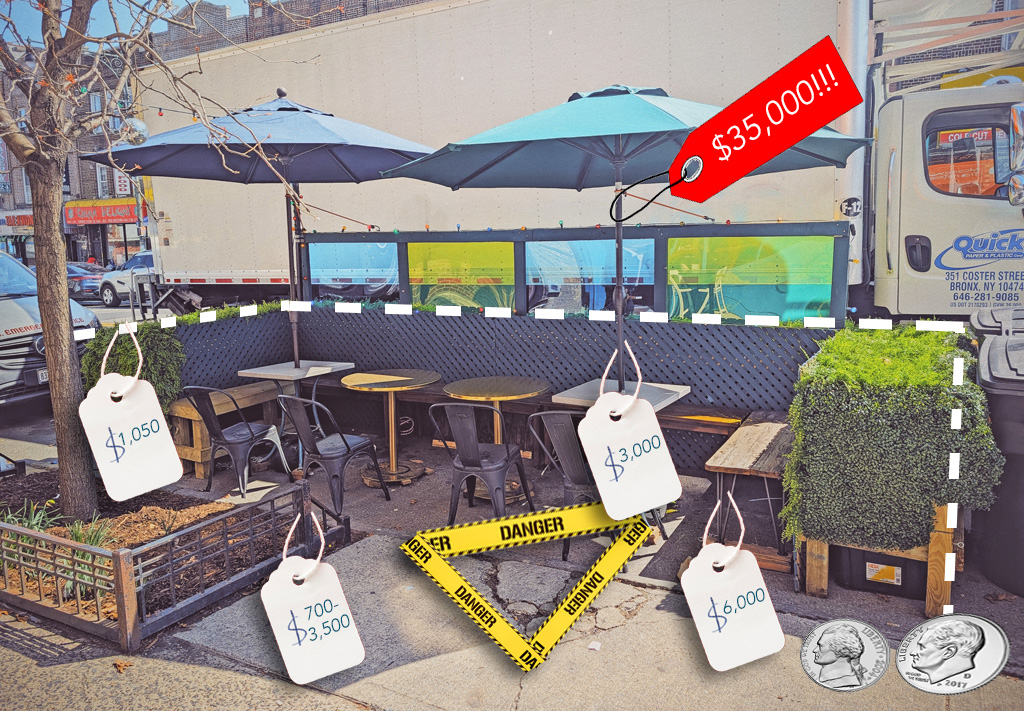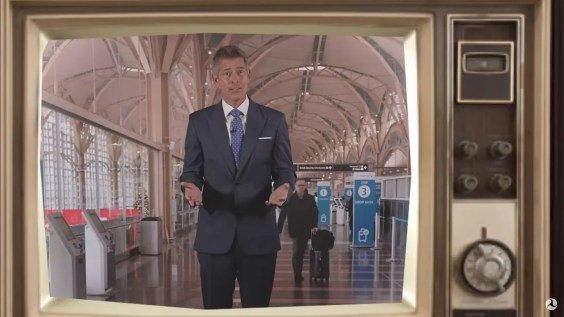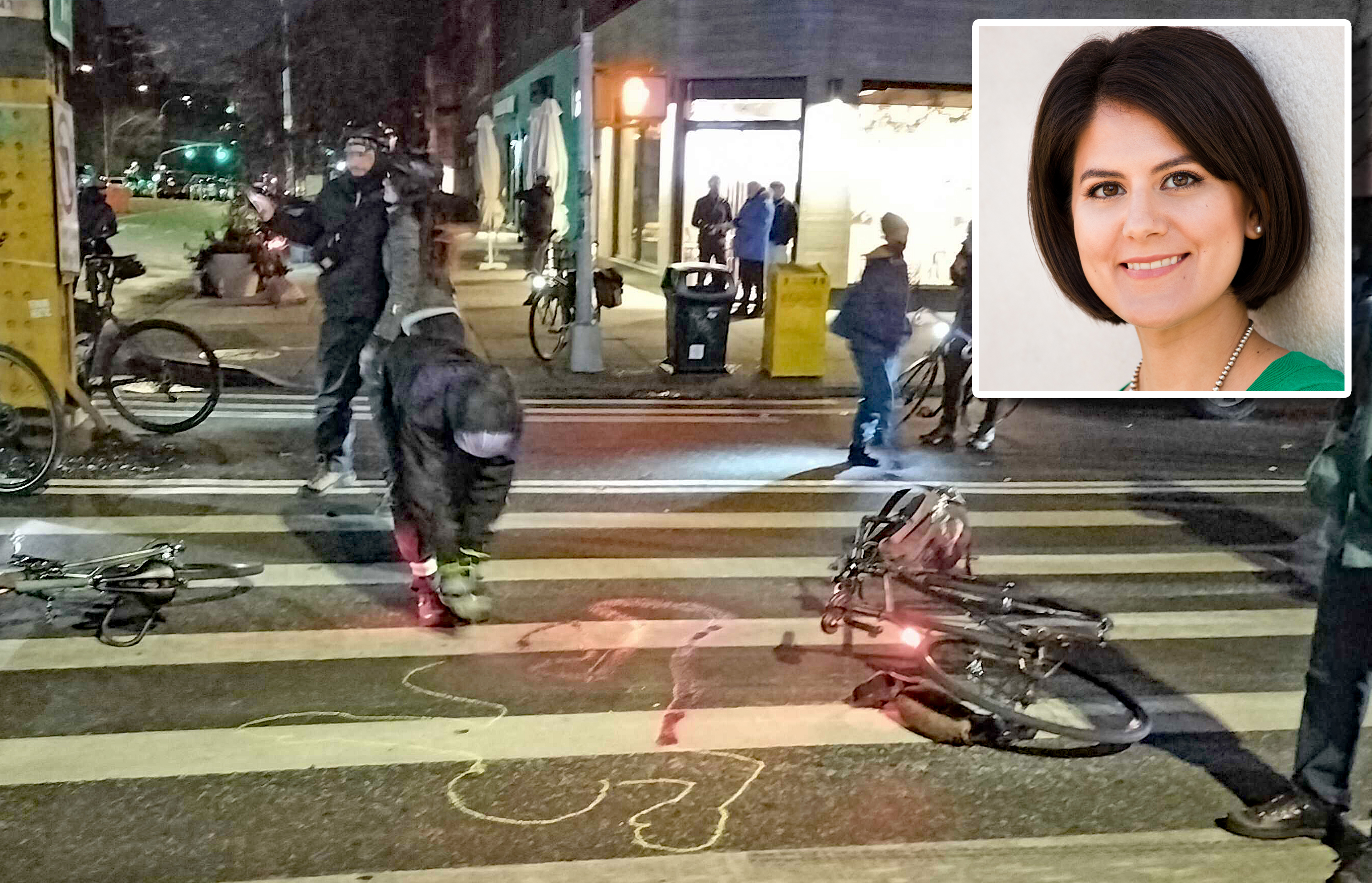Speed cameras are evenly distributed across the city, and are not disproportionately concentrated in low-income communities of color, despite a pervasive belief that the cameras are a money-making ploy that unfairly target Black and Brown neighborhoods, a Streetsblog analysis reveals.
A new map created by activist Brian Howald shows where in the city drivers are getting nabbed for speeding in school zones and blowing through red lights, revealing a pattern of inequity not based on the location of the cameras themselves, but where the city has failed to provide adequate infrastructure that protects vulnerable road users.
Some drivers — and pols — have long surmised that the cameras are merely a revenue scheme in communities of color, but an analysis of where they're located shows no correlation between the number of cameras and the racial demographics of a given community. The camera locations are largely equitable based on racial demographics.
The bottom line: cameras, which automatically slap drivers with a $50 ticket for exceeding the speed limit by more than 10 miles per hour, work. And they've helped lead to fewer crashes, injuries, and fatalities, said Queens Borough President Donovan Richards.
“Cameras don't discriminate. Either you're speeding or you're not. This data certainly proves what we've been saying all along," said Richards, who previously represented neighborhoods in southeast Queens in the City Council. "When the cameras started to go up, I would start getting inquiries from constituents on, 'Well, they only put these cameras up in Black and Brown neighborhoods.' So the data is very conclusive."
Howald, who is also the mastermind behind How's My Driving, used the database, Parking Violations Issued for Fiscal Year 2021, from the city's Open Data portal, to map the locations of all speed and red light cameras. (All of those locations are below, in one map, but separate maps for each type of camera are further down in this story):
It remains unclear who is being ticketed in the five boroughs, given that the cameras do not capture the driver's race or gender, and the city does not release the names or addresses of ticket recipients. A recent investigation by ProPublica added fuel to the concern of inequity over supposedly "race-neutral” enforcement cameras in Chicago, finding that 38 percent of the speed camera tickets were mailed to residents of majority-Black ZIP codes, despite the fact that those ZIP codes account for just 27 percent of Chicago’s population. The race of the recipient of the ticket is unknown. The ProPublica report also found that the cameras themselves were not disproportionately concentrated in Black neighborhoods.
So what is going on in New York City?
Speed cameras
Currently, 750 camera systems operate citywide — and their hours of operation have been extended so that they are issuing tickets between 6 a.m. and 10 p.m., not just during school hours. That change last year facilitated a dramatic drop in crashes and injuries, Streetsblog reported at the time.
Still, the naysayers persist. New Council Speaker Adrienne Adams last month sympathized with a speedster who doesn’t want to pay the price for her reckless driving — seeming to agree when the driver said it is a “well acknowledged” theory that speed cameras are a scam, a way to nickel and dime New Yorkers, often on the backs of communities of color. Adams's office declined to comment for this story.
It's not easy to prove the Speaker right or wrong because the Department of Transportation does not release the locations of speed cameras, which must be within a 1,320-foot radius of a school entrance or exit. Streetsblog requested the information and was told to file a formal Freedom of Information Law request, which was then turned down. [See sidebar below.]
But Howald was able to build a map using the city's massive database of camera-issued tickets, which indicate the location where the ticket was issued to a speeder. His analysis of the camera locations shows that they are, in fact, evenly distributed across all five boroughs, and are not disproportionately concentrated in low-income communities of color, said Marco Conner DiAquoi, Deputy Director of Transportation Alternatives.
"The speed safety camera program in New York City is large and very evenly distributed. We don’t see any correlation between the demographics of a zip code and the number of speeding violations there," said Conner DiAquoi. "What we see is a distribution that generally lines up with the makeup of New York City and where unsafe streets exist."
That bears repeating: Where unsafe streets exist.
Those four words reveal the real systemic racism of the enforcement camera program. Yes, the cameras are evenly distributed geographically in the city, though many tickets are issued in some low-income communities of color because of the wide, speedway-like arterials that cut through such neighborhoods, and which have not been redesigned for safety as they have been in White neighborhoods. The result is not only many speeding tickets written in those communities, but also that residents of those neighborhoods are disproportionately the victims of road violence.
"High amounts of speeding violations should immediately indicate an area that DOT needs to prioritize for street safety investments. We believe that automated enforcement will help us achieve Vision Zero, but can not be a substitute for street safety redesigns that will permanently reduce speeding and prevent traffic violence," said Conner DiAquoi.
And one of those outliers is in East New York and Cypress Hill, the most striking area on the speed-camera map. Those neighborhoods are home to the ZIP code of 11208 — where 54 percent of the residents are Black, and 59 percent of households don’t own a car, according to census data. Yet speed cameras issued a whopping 187,456 tickets in that ZIP code last year, the most in the city, according to the data. That’s roughly 513 speeding tickets per day. (The district is a true outlier, with roughly 100,000 more tickets than the next speediest ZIP code, Brooklyn’s 11234, in Flatlands and Mill Basin.)
But figures like those from 11208 are ultimately no surprise, given that the area's infrastructure encourages speeding — the ZIP code is home to major arterials such as Atlantic Avenue, Linden Boulevard, Conduit Boulevard, and the Jackie Robinson Parkway.
“The overarching concern is that the city has done very little, separate and apart from installing cameras, to really ensure street safety for our community. Just placing cameras ain't gonna cut it," said Wilfredo Florentino, the Transportation Committee chairman of Brooklyn Community Board 5, which encompasses stretches of those thoroughfares and sections of the 11208 ZIP code.
Florentino said he and other members of the community do support cameras — along with wholesale street redesigns and upgrades, not in lieu of them. Last year in that ZIP code, there were 1,272 reported crashes, or an average of 3.5 per day.
"Our community is disproportionately represented as it relates to speed cameras. We have an incredible opportunity to engage with the community in how we can re-envision and reimagine those thoroughfares," he said.
One of the thoroughfares offered a case study in why cameras are ultimately insufficient without proper design to rein in drivers. Last October, 56-year-old Jose Ramos was run down and killed at the corner of Essex Street and Atlantic Avenue in East New York. The city had been promising for more than a decade to redesign the roadway, but ended up maintaining its wide, six-lane configuration.
As a result, more than 50 people have been killed or seriously injured along the stretch where Ramos was killed in just five years, placing it in the top 10 percent of Brooklyn streets for severe injuries and fatalities per mile, Brooklyn state Sen. Julia Salazar wrote in an op-ed in Streetsblog last year, calling for a significant redesign of the roadway.
“Such senseless deaths unfortunately happen far too often in our city, but they can be easily prevented with investment in more protective pedestrian and bicycle infrastructure,” she wrote.
Richards agrees that cameras work, but not without pairing them with safe streets by design.
“There's still a lot of work that needs to be done around infrastructure in communities and communities of color. And I would be lying to you if I told you that tickets don't impact communities in different ways," he said. "I believe you should follow the law, but those tickets are going to impact a single mom living in public housing differently than somebody who may be making six figures or more a year."
Another example of how road design itself is racist is Seagirt Boulevard in Far Rockaway. In 2019, a camera at its intersection with Crest Road handed out the most speed camera tickets in the city, according to the Department of Transportation. Last year, that one camera issued 18,289 tickets, or roughly 50 per day, and an adjacent camera at Seagirt Boulevard and Beach 20th Street issued 11,982 tickets, according to the data. It remains unclear who is getting the tickets, but the fact that so many tickets get issued there is no surprise, given the width of the road itself.
No wonder members of the community are scared to cross Seagirt, whose intersection with Beach 20th Street was designated a Vision Zero Priority Intersection after 10 severe pedestrian injuries and two fatalities between 2014 and 2018, according to DOT.
"There’s a lot of crazy drivers out here," said Sharieal, who declined to give her last name, and who was waiting for the bus near Beach 26 Street on Tuesday afternoon.
Another bus rider told Streetsblog that she thinks drivers there are just following the lead of the cops.
"There's always speeding. Police speeding right through just to get past the light," said Heather, who also declined to give her last name.
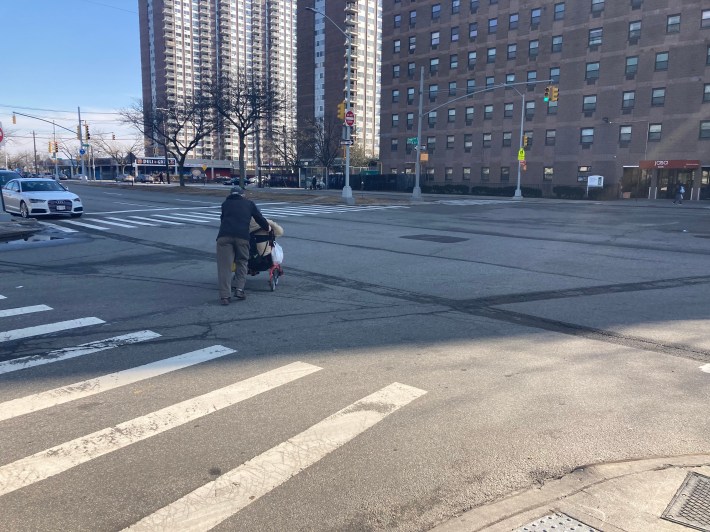
No one should be exceeding the speed limit by 11 miles per hour or more, said Richards, but the design of this road itself made it ripe for speeding: three lanes in each direction with no traffic-calming measures. In that ZIP code, 11691, cameras issued 58,171 speeding tickets in fiscal year 2021, according to the map and city records. That's roughly 160 tickets per day.
The cameras along Seagirt Boulevard first started issuing tickets in November, 2018, according to city records — contributing to a minimal, but clear, reduction in crashes and, specifically, injury-causing crashes, according to the data.
From November, 2015 through October, 2018, before the cameras went in, there were 352 reported crashes along the corridor between Rockaway Freeway and Beach Ninth Street, causing 131 injuries, and one fatality, according to Crash Mapper. But after the cameras went in, during the same three-year period from November, 2018, through October, 2021, there were 229 reported crashes along the same mile-long stretch, causing 87 injuries and one death. (The numbers may not be a direct comparison given the pandemic and the rise in speeding throughout the city within that timeframe.)
But apart from the speed cameras, the corridor has remained unchanged since at least 2007, according to Google images. And it wasn’t until October, 2021 that the city finally put the boulevard on its radar for a much-needed redesign that would facilitate drivers slowing down.
“We finally did push them to start to look at Seagirt Boulevard to do some treatments along it [because] it really became a speedway,” said Richards. “Cameras are one part of the solution.”
DOT proposed removing one lane of traffic in each direction to make room for a parking-protected bike lane, parking lane, and pedestrian space alongside the median — which a 84 percent of residents said they supported.
But work has yet to begin.
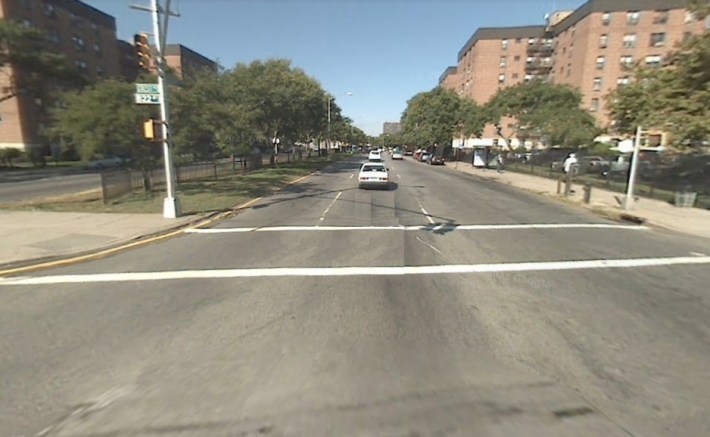
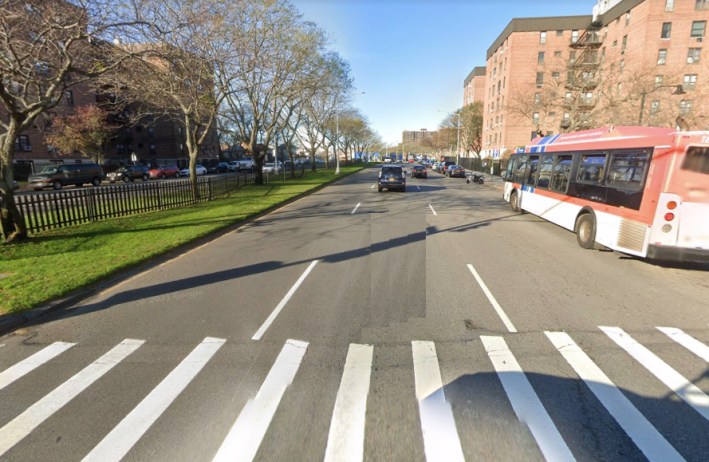
The city's failure to rein in drivers by redesigning roads for safety sometimes cuts across racial lines. The 10314 ZIP code, for example, is a sprawling part of western Staten Island known for high speeds, few crashes and a 90-percent White population.
Ironically, none of that part of the Rock is represented by Assembly Member Charles Fall, a North Shore Democrat who introduced a bill late last month to dramatically reduce the program because he believes it causes "an unfair burden on drivers." But the ZIP code at the center of Fall's district — 11310 — was in the bottom 10 ZIP codes for speed-camera tickets, and the district is majority Black and Latinx. Fall did not respond to a request for comment.
That bill is unlikely to make it out of committee, let alone pass, given that the legislature has been increasingly supportive of automated enforcement in an age of growing awareness of the potential danger of police stops of drivers. Cops are 40 percent more likely to stop a Black driver than a White driver, studies show — interactions have led to police brutality and death.
Besides, the mother of one road violence victim — who lives in Fall's district, and whose son, Imorne Horton, was killed at the dangerous intersection of Hamilton Avenue and Court Street last February — said now is the time to strengthen automatic enforcement, not weaken it.
“Traffic violence on New York City streets is a public health epidemic. After my son was killed by a hit-and-run driver, my family has had to live with the painful consequences of our unsafe streets every single day," said Tasha Horton, a member of Families for Safe Streets. "No other family should experience such horrific loss. That is why we need to expand and strengthen the speed safety camera program. Now is not the time for elected officials to turn their back on Vision Zero."
Red light cameras
The city’s red light program — the first in the nation — launched in 1994 after authorization from the state, and has been extended by legislators in Albany eight times. The most-recent extension will expire at the end of 2024. Here's a map of all the red light cameras:
But unlike the city's robust speed camera program, red light cameras are rare; by law, they are allowed at just 150 intersections, which is fewer than one percent of the city's nearly 40,000 intersections. Large swaths of the city have no red light cameras at all, leaving residents there more vulnerable to traffic violence.
The program, albeit small, has helped reduce the number of severe injuries in collisions — at intersections with red light camera enforcement, severe injuries dropped by 58 percent from the three years prior to a camera's installation, according to a 2021 report from the Department of Transportation.
The agency says that locations are selected based upon several factors, including crash history, engineering feasibility, and community and elected official requests. And typically, red light cameras are placed on or adjacent to major, arterial streets, which carry high volumes of vehicles with a high frequency of violations.
Still, many areas and intersections where they are needed have none — including Flatbush in Brooklyn, and specifically, Foster Avenue and E. 17th Street, where earlier this month, the driver of a gray Chevy hit and killed a 64-year-old woman after going through a red light, according to police.
That corner is part of a much larger hole in the map, one of many. A large area of Brooklyn between Eastern Parkway on the north and Newkirk Avenue lacks any red light cameras.And Jackson Heights and Corona. And Long Island City. And most of the Bronx.
The same is true for all of Bay Ridge, which is surprising, given neighborhood drivers’ proclivity to speeding and recklessness.
Democrat Andrew Gounardes, the current state Senator who succeeded camera-antagonist and speedster himself, Marty Golden, says he doesn’t know why that portion of his district is absent of red light cameras.
According to Community Board 10 District Manager Josephine Beckmann, residents have asked for more, including at 65th Street and Sixth Avenue, 65th Street and 12th Avenue, and 101st Street and Fourth Avenue, but DOT rejected the requests, she said.
Gounardes says he wants more red light cameras to catch the bad drivers that hit and kill people like Kamel Mahmoud, a 72-year-old who was left for dead last year less than a mile from his home after being struck by a still-unidentified driver while crossing Bay Ridge Parkway near Sixth Avenue in the crosswalk with the light.
"Right now, the statute is one percent of intersections of the city, we’re working with Transportation Alternatives to try to increase that pretty significantly," he said.
And in Williamsburg and Greenpoint, specifically on McGuinness Boulevard, there's also a gaping hole — similarly shocking given several fatalities along that very corridor, including the death of a beloved local teacher, Matthew Jensen, who was killed by a hit-and-run driver near Bayard Street on May 18.
McGuinness Boulevard does have plenty of speed cameras, according to the map. But the local pol who represents North Brooklyn up in Albany told Streetsblog that she's "disturbed" by the lack of red light cameras in those areas.
“We have lots of hit-and-runs in this district. I do think it’s really interesting they’re so thin up in my district,” said Assembly Member Emily Gallagher. "There’s huge areas of the city where it’s very car-centric, but the cameras are just not a presence there. I think the program is a little conservative, we shouldn't have so many restrictions where they can and can’t be.”
And over in Manhattan, the Upper West Side is yet another area where there are very few cameras, despite many drivers who don't follow the law. Upper West Side Council Member Gale Brewer said she’s been a supporter of cameras since their earliest inception, and wants more.
“I went from one end of Manhattan to the other, I never saw so many people go through red lights," said the former Manhattan Borough President. "I’d love to see more of both. I want all the red light cameras I can get.”
These pols are not alone in their desire for more automated enforcement to catch scofflaws — a majority 85 percent of New York City voters, including 84 percent of those who own cars, support installing more red light cameras, according to a Transportation Alternatives poll conducted by The Siena College Research Institute in 2020.
SIDEBAR: What's with the DOT and camera locations?
Given a prevailing belief in some communities that speed cameras are an unfair tax on Black drivers or are disproportionately located in Staten Island, Streetsblog has long sought the exact locations of speed cameras to assess such claims. But the Department of Transportation has steadfastly, over many years, refused to provide the locations.
In December, 2020, Streetsblog filed a formal Freedom of Information Law request for the camera locations on the grounds that "the agency has no compelling reason to deny the public access to the database of all camera locations, according to our legal counsel."
On July 1, 2021, the DOT turned down our request, claiming that such records are "exempt from disclosure" under FOIL because an agency may deny access to records that:
- "are compiled for law enforcement purposes and which, if disclosed, would interfere with law enforcement investigations or judicial proceedings, deprive a person of a right to a fair trial or impartial adjudication, identify a confidential source or disclose confidential information relating to a criminal investigation, or reveal criminal investigative techniques or procedures, except routine techniques and procedures."
- "if disclosed could endanger the life or safety of any person."
- "if disclosed, would jeopardize an agency’s capacity to guarantee the security of its information technology assets, such assets encompassing both electronic information systems and infrastructures."
Our lawyer, Ava Lubell of Cornell Law School, moved to appeal, but first reviewed existing advisory opinions. It turns out that the state's Committee on Open Government had indeed weighed in on speed cameras back to 2008, citing a 1979 ruling that found that “an agency could not justify a denial of access when disclosure would encourage compliance with or better understanding of the law.” Indeed, the Committee argued that the “disclosure of the location of the cameras would likely deter speeding or running red lights, thereby enhancing public safety and compliance with law.”
The Committee also noted that a routine internet search reveals the location of many of the cameras, and many more are found on such apps as Waze. As such, there's no compelling legal argument "that disclosure somehow interfered with law enforcement or public safety."
And the state's highest court ruled in Newsday v. State Department of Transportation (2005) that any records showing that officials are making roadways safer are public documents. (In that case, a reporter was seeking, and was ordered to be given, "a priority list of hazardous intersections and locations.)
The body of case law and advisory opinions end is only one pillar of our legal case, Lubell said. On July 30, 2021, she appealed the denial, citing the agency's own 2020 report which stated that “[a]t intersections with red light camera enforcement, severe injuries fell by 58 percent overall from the years just prior to the program’s establishment to 2018.”
"Put differently," Lubell wrote, "there is ample evidence to suggest that when individuals learn the location of red light cameras, they stop speeding at those locations, thereby enhancing public safety."
The DOT again denied our request on Aug. 18, 2021, citing the same reasoning already debunked by the Committee on Open Government.
Undeterred, Lubell wrote to the Committee to get a new advisory opinion, which was sent to us on Oct. 27, 2021. It upheld the Committee's prior findings that speed- and red-light camera locations are public information subject to FOIL. The Committee added in a new wrinkle, arguing that the DOT's first reason for denial — namely, that knowledge of the location of cameras would "interfere with law enforcement investigations" — is absurd because the agency "appears to be unable to demonstrate knowledge of the underlying strategy of a specific law enforcement investigation or judicial proceeding [so] it cannot claim to have the demonstrable knowledge of 'interference' with such investigation or proceeding."
We sent the Committee finding to the DOT late last year and have not heard back.
